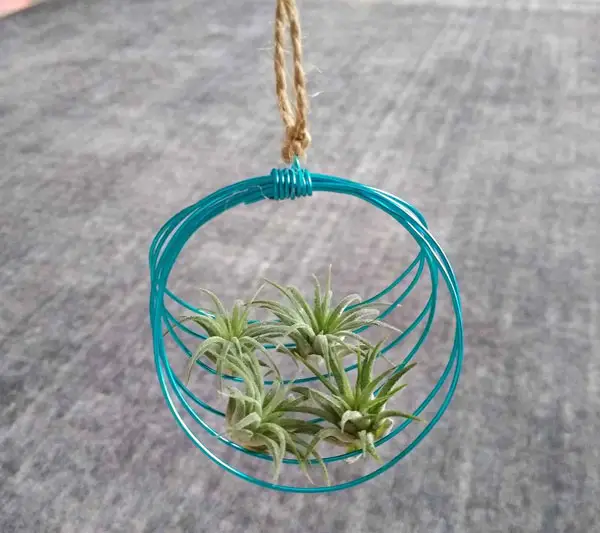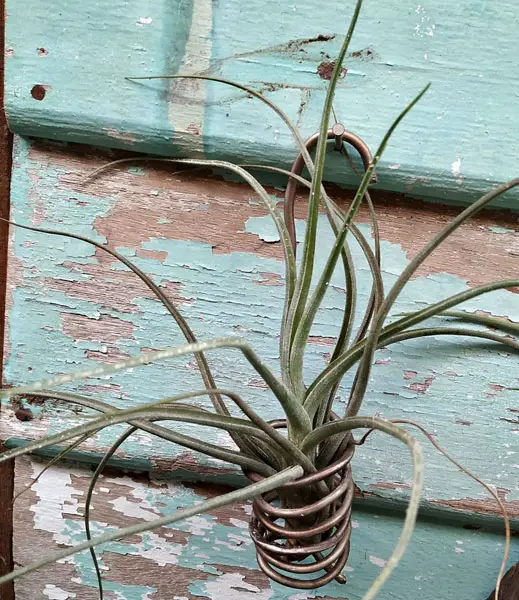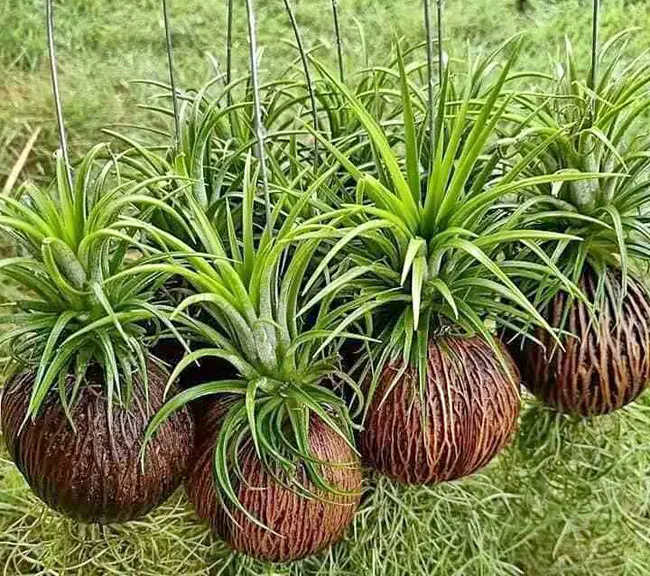Have you ever wondered how to take care of air plants? It’s easy! I’m here to help. As an air plant care specialist, it is my mission to make sure that everyone knows the basics of caring for these fascinating little plants. Caring for your air plants doesn’t need to be complicated – with just a few simple steps, you can keep them looking their best and thriving in your home or office. In this article, I’ll give you all the info you need so that you can confidently look after your air plants and enjoy their beauty up close.
Air plants are such interesting creatures; they don’t require any soil to grow and are perfect if you want something exotic indoors without too much hassle. Their unique characteristics also mean that they require some special attention in order to thrive. But don’t worry – by following a few guidelines, your air plants will stay healthy and beautiful no matter where they live.
Air plants are pretty yard decorations that can give your trees a little personality but taking care of them takes a little work. Some sources say that they are easy to maintain, but others say they need more attention—so what’s the truth? Are air plants easy to take care of?
While it is true that these plants are easy to care for at a basic level, there are some essential tricks that you’ll need for tending to your air plant. Let’s dig into what we’ll have to do to keep your air plant alive and well.
Ideal Growing Conditions
Air plants are easy to care for and make great additions to any home. It’s important that you understand the ideal growing conditions for your air plant, so it can thrive in its environment.
First and foremost, these plants need good airflow. This is why they’re often found mounted on driftwood or hung from macrame hangers. Placement near windows or fans will ensure they receive proper ventilation while keeping them safe from pets and children.
When it comes to moisture levels, don’t be fooled by their desert-like origins! Air plants require regular watering – usually once a week – either with misting or submerging in water for 10 minutes at a time. After each bath, give them plenty of time to dry before rehanging them; otherwise, their leaves could rot away.
How to Plant Air Plants
Air plants are unique because they don’t need soil to root and grow. They are epiphytes, a fancy way of saying that they grow on other plants.
Air plants require fresh air, hence the name air plant. Without good air circulation, moisture can build up on the plant, causing it to rot, catch fungal infections, and die. Therefore, it’s a good idea to stay away from aquariums and other containers. They won’t allow your air plant proper air circulation and ultimately lead to the air plant’s untimely demise.
It’s best to stick with outside or on approaches if you live in more tropical climates, their natural habitat. If you do have them inside, choose a well-ventilated room with plenty of indirect light.
Light Requirements
Now that we’ve discussed ideal growing conditions, let’s talk light. Air plants need bright, indirect sunlight in order to thrive and grow. Place your air plant near a window or another source of natural light for about six hours per day. Take care not to expose it directly to the sun as this can cause damage and even death due to intense heat and direct UV rays. If you don’t have access to enough natural light, consider using a fluorescent lamp or LED bulb set up at least 12 inches away from the plant.
It is important to remember that too much sun can be just as harmful as too little. As such, keep an eye on how your air plant looks when exposed to different levels of light – if its leaves start turning yellow or brown, move it further away from the windowsill!
Make sure that you rotate your air plant regularly so all parts get equal amounts of exposure to the light source. This helps promote healthy growth and lush foliage throughout the entire plant body. Now let’s take a look at watering frequency and technique – an essential part of taking care of your precious air plants!
Watering Your Air Plants
Watering an air plant isn’t the same as watering most other plants, but it’s not as labor-intensive — just time and perhaps money intense!
For starters, the minerals found in tap water can keep your air plant from absorbing nutrients. Some locations have tap water that is low in mineral content and will work just fine, but if you live in an area with mineral-heavy tap water, you may need to use captured rainwater or bottled purified water. Tap or countertop filters may not remove the minerals, either.
Here’s how to properly water an air plant:
- Fill a tub with tap water (or rainwater if you have mineral heavy water)
- Completely submerge it for 20 minutes to an hour
- After the time is up, shake as much water off of the plant as you can
- Set it out to dry in a warm, well-ventilated spot. If it takes longer than a couple of hours to fully dry, the air plant could begin rotting; make sure it has enough circulation to dry before that.
You will want to go through this watering routine once every week, no less than every ten days. If your air plant looks a bit dry in between watering, you can lightly mist it with water (but not so much it drips off the “leaves”).
A general rule of thumb is every 7-10 days during warmer months, and then reduce this frequency by half or more during cooler months. Additionally, always allow the soil/medium to dry completely between each watering session.
When it comes time to actually water your air plant, submerge them in tepid or room temperature water for about 20 minutes so that the entire surface has been soaked through (it helps if you agitate the leaves gently while submerged). Afterward, shake off any excess droplets from the foliage and place them back into its pot or container away from direct sunlight as soon as possible. When done correctly, these steps should keep your air plants happy and healthy!
Fertilization Considerations
When it comes to fertilizing your air plants, a little bit goes a long way! Although some people may think that their air plants need heavy doses of fertilizer or special concoctions, the truth is that they really only require very minimal amounts. To ensure maximum health and growth, here are a few tips on how to go about fertilizing:
- Use an organic liquid fertilizer specifically designed for air plants.
- Dilute the fertilizer before use – usually, one part fertilizer to four parts water works best.
- Fertilize every two weeks during spring and summer and once per month in winter.
- Be sure not to over-fertilize as this can cause damage and even kill your plant.
It’s important to note that although the regular application of fertilizer will boost your air plant’s growth, it isn’t essential for survival. With proper care and attention, many air plants don’t require any additional feeding at all.
Temperature Regulation
Temperature is one of the most important parts of air plant care. I always recommend keeping your plants in a warm spot, away from cold drafts and heaters. Ideally, you want to keep them at around 65-85°F (18-30°C) during the day, with nighttime temperatures dropping no lower than 55°F (12°C). If it gets too hot or too cold for a prolonged period of time, their leaves may start to curl up – so be sure to keep an eye on this!
Something else to consider is that air plants need bright light but not direct sunlight. Too much sun can quickly dry out your plant’s cells, leading to premature death if left unchecked. To ensure they get enough indirect light, place them close to windowsills or use artificial lightings such as LED bulbs or fluorescent lights.
Don’t forget about watering! Air plants should be misted regularly every few days or once per week depending on how humid your environment is. This will help maintain temperature levels and prevent dehydration – both essential elements for healthy air plants.
Humidity Requirements
Air plants need a certain amount of humidity to thrive. They prefer environments with 40-60% relative humidity, and they can tolerate up to 80%. Here are some ways to create the perfect environment for your air plant:
Misting:
- Regularly mist the leaves of your air plant – this is especially important in dry climates or during winter months when the air is naturally drier.
- Use rainwater if you have access to it as tap water can contain minerals that could potentially harm your air plant over time.
- Make sure not to overdo it though! Too much misting will cause mold growth on your air plant’s leaves, leading to root rot.
Soaking:
- Every 1-2 weeks, submerge your air plants in lukewarm water for at least 20 minutes (but no more than 2 hours). This helps ensure that all parts of the plant get hydrated evenly.
- After soaking them, shake off excess moisture and lay them out horizontally until completely dry before returning them back to their container/terrarium/vase.
Humidifier:
- If you live in a particularly dry climate, consider investing in an ultrasonic humidifier and placing it near your air plants. These devices emit cool mist which keeps the area around your plants moist without risking any potential damage from hot steam or splashes of water like other forms of humidification tend to do.
Pest Prevention And Treatment
When it comes to air plants, pests are something you want to be aware of. Most problems come from mealybugs, aphids, and scale insects. These can cause stunted growth, discoloration, and even death in your beloved air plant if left untreated for too long. To prevent these pests from taking over your collection, regular inspection is key – inspect both the undersides of leaves as well as any axils where the leaf meets the stem.
If you do spot anything unusual on your air plants, don’t panic! Often a simple mix of water with dish soap or rubbing alcohol can take care of the pest problem without causing any damage to your plant. For more stubborn cases, an insecticidal spray may be necessary – just remember not to use this too often as it might harm your precious specimens.
Air Plant Arrangements
Now that your air plants have been treated for pests, it’s time to start arranging them in a beautiful display. There are many ways you can showcase these delightful and resilient little wonders. You could opt for an indoor terrarium, or hang your air plants from the ceiling with twine. They look stunning when grouped together in glass vessels and suspended from driftwood branches.
When selecting containers for your arrangements, be sure to choose ones made of materials that will allow airflow – like clay, metal, or wood. Additionally, make sure all portions of the plant can get enough light by placing them near windows or using artificial lights such as LED strips or lamps.
When deciding on how to arrange your air plants, remember to keep the growth habit and size of each species in mind. Some may need more space than others so try not to overcrowd them! Also consider adding other elements into the mix like stones, shells, mosses, and lichens – whatever inspires you! And don’t forget about water; some plants just love a good misting every now and then while others prefer soaking up their much-needed moisture through their leaves instead.
Tips For Healthy Blooming
Did you know that air plants only bloom once or twice a year? This means that with the right care, they can be counted on to produce an amazing display of color and texture during their blooming period. Properly caring for your air plants will help ensure these moments are as beautiful as possible.
First, make sure your air plants get plenty of light. They need at least 12 hours of indirect sunlight each day in order to thrive. If you don’t have access to natural light, you can use artificial lighting like fluorescent lights or LED grow lights instead. Another important factor is water–air plants should be soaked in room temperature water for 10-15 minutes every other week (or more often if needed). After soaking, shake off any excess moisture and let them sit until completely dry before returning them back to their original location. Lastly, fertilize your air plant regularly with a diluted liquid fertilizer solution throughout its growing season.
Pruning Air Plants
It’s ok to prune your air plant. Over time, the plant’s leaves will turn brown and fall off. There is nothing wrong with removing any dead brown leaves.
The roots of the air plant serve to anchor it to its host, usually a tree but serve no other purpose, so you can trim them without causing damage to the plant. Alternatively, you can use them to attach the plant to whatever you’d like using an adhesive.
The Propagation and Bloom of Air Plants
Air plants will bloom only once in their entire life. The blooms can be quite beautiful; unfortunately, the bloom signifies that the plant will die. “Baby” air plants manifest as sprouts at the base of the plant called pups. An air plant can produce one to three pups after its bloom.
These pups are baby air plants and can be removed from the mother plant when they are between one-third and one-half of its size.
When removing the pups from the parent plant, keep in mind that they should be easy to remove. So, if you find that there is too much resistance: wait. Please don’t force it, or you’ll risk damaging both the parent plant and the pup.
To remove a pup from the parent air plant:
- Support the mother plant with one hand.
- With your free hand, gently grip the pup at its base.
- Gently pull away. If the pup doesn’t come off easily, then it’s not time to remove it yet.
If the pup is ready to strike out on its own, then it’ll put up no resistance and will break away clean, leaving no damage to the mother plant.
How to Deal with Clumping Air Plant Pups
If you decide to leave the pups on the parent plant, they will eventually start clumping and creating an impressive string of continually blooming plants. Once they have clumped up, you can continue to maintain them as ordinary air plants.
Troubleshooting Common Issues
Although air plants are relatively low-maintenance, they can still experience issues. Fortunately, troubleshooting common problems is easy with the right information and tools. Here are a few of the most common issues you may encounter:
Watering Issues:
- Too little watering: Air plants need to be watered often enough for them to stay hydrated. If your plant is looking dry or wilted between waterings, it likely needs more frequent waterings.
- Too much watering: Overwatering an air plant can cause root rot, which will eventually kill the plant if not treated quickly. To avoid this problem, make sure that any excess water drains out of the pot after each watering so that the roots don’t sit in standing water.
Temperature Fluctuations:
Air plants prefer temperatures around 70 degrees Fahrenheit during the day and 55 degrees at night. Extreme temperature fluctuations can lead to stress and the eventual death of your air plant if left unchecked. Make sure to keep your air plant away from direct sunlight or drafts, as both can cause extreme temperature changes.
Long-Term Maintenance
Long-term maintenance of your air plant is essential for its continued health. There are several key ways to ensure that your air plants remain in optimum condition. They should be misted lightly once a week with lukewarm water – never use cold or hot water! It’s also important to make sure that the plants get enough light and airflow; placing them near an open window or on a balcony can help here.
Keep an eye out for any signs of pests such as mealy bugs or spider mites, and take action if necessary. With these simple steps, you’ll ensure that your air plant will thrive for years to come!



